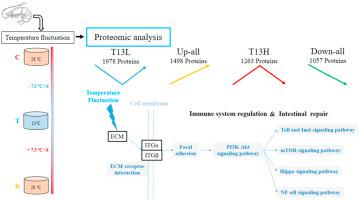Fish & Shellfish Immunology ( IF 4.7 ) Pub Date : 2020-09-12 , DOI: 10.1016/j.fsi.2020.09.014 Zhenlu Wang 1 , Lei Wang 2 , Jiang Zhou 1 , Jixing Zou 1 , Lanfen Fan 1

|
To investigate shrimp immunoregulation and tissue self-repair mechanism during temperature fluctuation stage, Litopenaeus vannamei (L. vannamei) was treated under conditions of gradual cooling from an acclimation temperature (28 °C, C group) to 13 °C (T group) in 2 days with a cooling rate of 7.5 °C/d and then rewarmed to 28 °C (R group) with the same rate. Tandem mass tags (TMT) -based proteomics technology was used to investigate the protein abundance changes of intestine in L. vannamei during temperature fluctuation. The results showed that a total of 5796 proteins with function annotation were identified. Of which, the abundances of 1978 proteins (34%) decreased after cooling and then increased after rewarming, 1498 proteins (26%) increased during the whole stage, 1263 proteins (22%) increased after cooling and then decreased after rewarming and 1057 proteins (18%) decreased during the whole stage. Differentially expressed proteins such as C-lectin, NFκBIA and Caspase may contributed to the regulation of immunity and tissue repair of shrimp intestine during the temperature fluctuation stage. These findings contribute to the better understanding of shrimp’ regulatory mechanism against adverse environment.
中文翻译:

使用基于TMT的蛋白质组学在温度波动期间对南美白对虾的免疫调节和组织修复的新见解。
为了研究虾在温度波动阶段的免疫调节和组织自我修复机制,对南美白对虾(L. vannamei)在逐渐冷却的条件下从适应温度(28°C,C组)降至13°C(T组)进行处理。 2天,冷却速率为7.5°C / d,然后以相同速率重新加热至28°C(R组)。基于串联质量标签(TMT)的蛋白质组学技术被用于研究南美白对虾肠道蛋白质的丰度变化在温度波动期间。结果表明,总共鉴定出具有功能注释的5796个蛋白质。其中,1978年蛋白质的丰度(34%)在冷却后降低,然后在重温后增加;在整个阶段中,1498个蛋白质(26%)在整个阶段增加,在冷却后的1263个蛋白质(22%)在重温后增加,然后减少; 1057个蛋白质(18%)在整个阶段下降。在温度波动阶段,差异表达的蛋白质如C-lectin,NFκBIA和Caspase可能有助于调节虾肠道的免疫力和组织修复。这些发现有助于更好地了解虾对不利环境的调节机制。



























 京公网安备 11010802027423号
京公网安备 11010802027423号